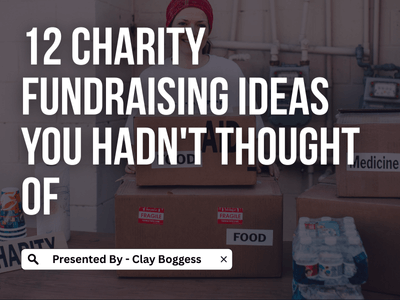
Practical tips for ramping up your next virtual fundraising campaign.
Your website is the nexus of your organization's outreach: supporters go to learn more about your cause, donate, and find new ways to support your work. You probably already know your website matters greatly, but sometimes keeping track of the nitty gritty technical details can be daunting.
Whether you're the tech wizard on your team or are still learning the ins and outs of your website, you can do more to make your nonprofit's website generate more value for your mission. How? By focusing on how your website can transform your online fundraisers.
According to Cornershop Creative's guide on digital fundraising, online fundraisers are one of the best ways to raise money for your nonprofit. Not only is an online fundraiser the most convenient option for donors looking to contribute, but it also can facilitate deeper levels of engagement among your supporters. But you must ensure your website is in tip-top shape to gain these benefits. Here's how to best leverage your website for online fundraisers:
- Make it easy to donate.
- Create high-quality content.
- Use awesome visuals.
- Take advantage of peer-to-peer fundraising opportunities.
Your website has amazing potential: it's a great place to experiment with creative new ideas and communication opportunities. Supporters love it when a nonprofit puts its unique twist or personality into its work, so don't hold back, especially when you're asking for donations. Plus, a great branded online experience can make your nonprofit memorable, inspiring donors to return. Check out these tips and take your online fundraisers to the next level!
Make it easy to donate.
Every day, it seems like life gets busier and busier. It's too easy to get distracted between work, kids, relationships, and all the notifications that constantly flood our inboxes. Even supporters with the best intentions can easily forget to donate or become frustrated by long, complicated forms. The easiest way to avoid this kind of donor burnout is to prioritize convenience and ease in your donation process.
Here's how to make donating to your organization as easy as possible:
- Ensure your donate button is easy to find: Donations fuel your organization, so you should design your website with fundraising in mind. That means ensuring that your donors can easily find where they need to go to contribute. Whether you have a big "Donate Here!" button in the top right corner of your website or a banner across the top of every page, make sure your donation options are clear and easy to spot.
- Keep forms short: It's easy for donors to walk away if they have to fill out a donation form, so keep your forms short and sweet for new donors. Only ask for the information you need. For instance, if you're running a school fundraiser, how can your supporters save their information to accounts so that parents who have already donated do not need to continue entering the information you already have? To keep your forms short, you can always send a follow-up email asking for additional information that you don't need to process the donation but would be nice to have in your records.
- Prompt donors to check for matching gifts: Matching gifts are a fantastic but often underutilized resource for nonprofits, usually because it can be difficult for donors to verify their donations with employers. Rather than chasing down donors after they've already contributed, use matching gift software to automatically prompt donors to search for their eligibility immediately following the giving process. This Double the Donation guide on corporate giving programs can explain everything you need to know about how matching gift programs work and what your nonprofit can do to get the most out of them!
Ease is a key factor in whether a donor contributes to your fundraiser. Since most donors will contribute to your organization via your website or a customized online donation page, the process must be quick and easy.
Create high-quality content.
Now that you've made it as easy as possible for supporters to donate, you need to give them a reason why they should. That's where your website content can come in to help.
High-quality content is one of the best ways to demonstrate professionalism and knowledge of your cause. When creating high-quality content, you should:
- Optimize for search engines: Search Engine Optimization (SEO) is increasing traffic to your website by optimizing your web content for search engines. You should optimize your nonprofit's website for search engines by following certain guidelines, such as using relevant keywords throughout your blog and making your website accessible. This way, when supporters search for information about your work or cause, your organization will be the first to appear in the search results.
- Write about what your supporters want to read: What makes your supporters so passionate about your nonprofit? Whether you've spoken with your organization's supporters directly or sent out surveys to learn about their interests, use the information you have to design your online fundraising campaign around what is most interesting to your supporters.
- Use storytelling: Everyone loves a compelling story. Share a great story with your supporters to deepen their understanding of your cause and ignite their passion for your nonprofit. Be sure to center your story around an interesting character and emphasize how your nonprofit's work made a difference with help from generous donors.
Your supporters have already demonstrated passion for your cause by coming to your site, so now you continue to share information that interests them. Develop a consistent brand voice that aligns your content with the branding of your broader organization. This makes sure your supporters feel most connected to your nonprofit.
Use awesome visuals.
Graphics and images are a crucial part of your nonprofit's website. They can help break up long text and create a better first impression for visitors to your site. While you likely already have images on your website, there are a few best practices to follow:
- Maintain consistent branding: From the type of imagery you use to the colors and borders used in your images, consistent branding across image styles on your website ensures that your nonprofit is easily recognizable. This way, donors can trust they're in the right place when they click to contribute.
- Optimize for mobile viewing: Did you know that over 90% of the global internet population uses a mobile device to go online? For this reason, ensure your images are optimized for mobile devices. Verify that the images load quickly and don't appear too big or too small.
- Make images shareable: Social media is a key way for donors to communicate with each other and share their passion for your cause. So if you have a great image, make sure it's shareable! This way, your donors can help spread the word and raise awareness about your cause with your best images or graphics.
Use awesome images or graphics to your advantage. Eye-catching visuals keep your website visitors engaged, and maintaining this engagement is crucial for any online fundraising campaign.
Take advantage of peer-to-peer fundraising opportunities.
Online fundraising opens up many possibilities, and your website is the perfect place to showcase these new opportunities! One of our favorite ways to leverage your website for online fundraising is to incorporate peer-to-peer fundraising strategies into your campaigns.
Over recent years, peer-to-peer fundraising has become increasingly popular, mostly because nonprofits have figured out how to use digital fundraising tools and their websites to encourage their most passionate supporters to raise money on their behalf. Here are a few tips you can use to add or expand your peer-to-peer fundraising efforts:
- Create customizable personal fundraising pages: Remember when we said your website was an opportunity to unleash your creativity? Your supporters would probably love to do the same with their peer-to-peer fundraising efforts! Allow supporters to create their fundraising pages to share with families and friends while they fundraise on your behalf.
- Use gamification tools: A little friendly competition never hurts anybody! Incorporate gamification tools, such as leaderboards and fundraising thermometers, into your peer-to-peer fundraising campaigns to encourage your fundraisers to stay motivated.
- Spotlight peer-to-peer leaders on your website: Using your nonprofit website builder, create a dedicated section of your website to highlight the accomplishments of your biggest supporters. This way, your current fundraisers will feel even more appreciated while inspiring others to join your campaign!
Peer-to-peer fundraising is a great way to empower your supporters to make a difference, and your website is the best resource you can use to deliver a high-quality experience and inspire repeat supporters and donors!
For an additional resource on planning ideas for your next campaign, download our free fundraising tips eBook from our school fundraising tips page.
_______________________________________
A great website can open a lot of doors for your nonprofit, especially in the realm of fundraising. By prioritizing your donor's online experience, providing content that supporters care about, and giving them the tools they need to get involved, you'll create an excellent website to drive donations.
Guest Author Bio
Director of Digital Strategy at Cornershop Creative – Self-described as a “non-profit junkie,” Sarah has dedicated her career to serving the needs of the non-profit sector. Her project management experience spans a variety of non-profit management disciplines including strategic planning, community engagement, capacity building, fundraising and research. She has worked both in and for the non-profit sector at the Feminist Majority Foundation, the Sadie Nash Leadership Project, and the consulting firms The Lee Institute and The Curtis Group. With her ever expanding non-profit tool belt, Sarah joined Cornershop Creative to tap into her techie, creative side, while developing meaningful partnerships with her clients to help them more effectively achieve their goals.



